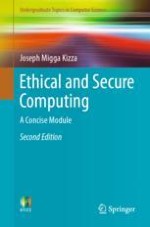2019 | OriginalPaper | Chapter
10. Evolving Realities: Ethical and Secure Computing in the New Technological Spaces
Artificial Intelligence, Virtualization, and Cyberspace
Author : Joseph Migga Kizza
Published in: Ethical and Secure Computing
Publisher: Springer International Publishing
Activate our intelligent search to find suitable subject content or patents.
Select sections of text to find matching patents with Artificial Intelligence. powered by
Select sections of text to find additional relevant content using AI-assisted search. powered by
